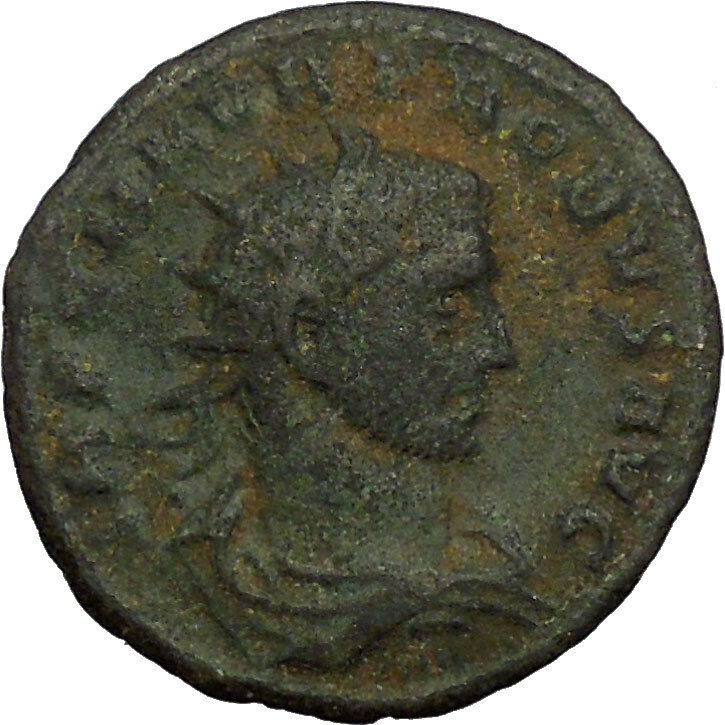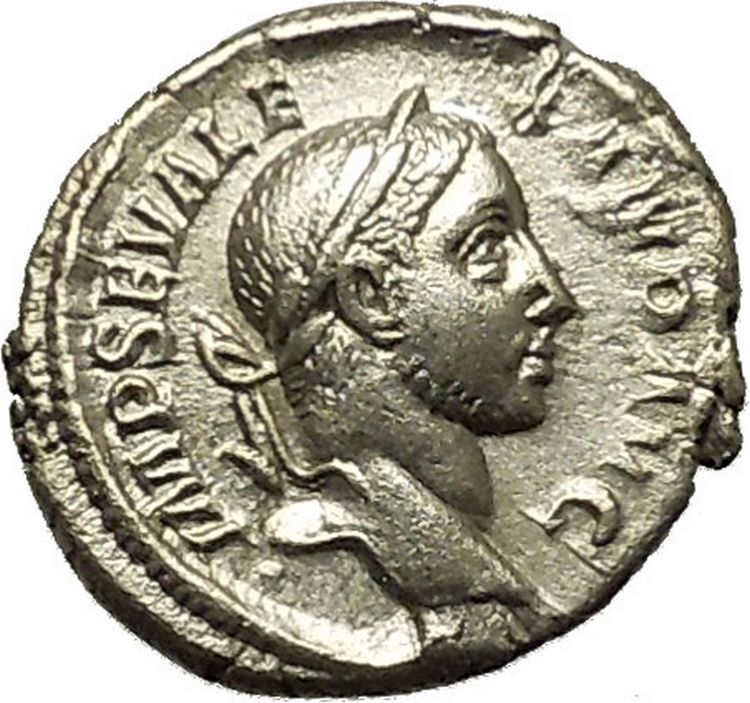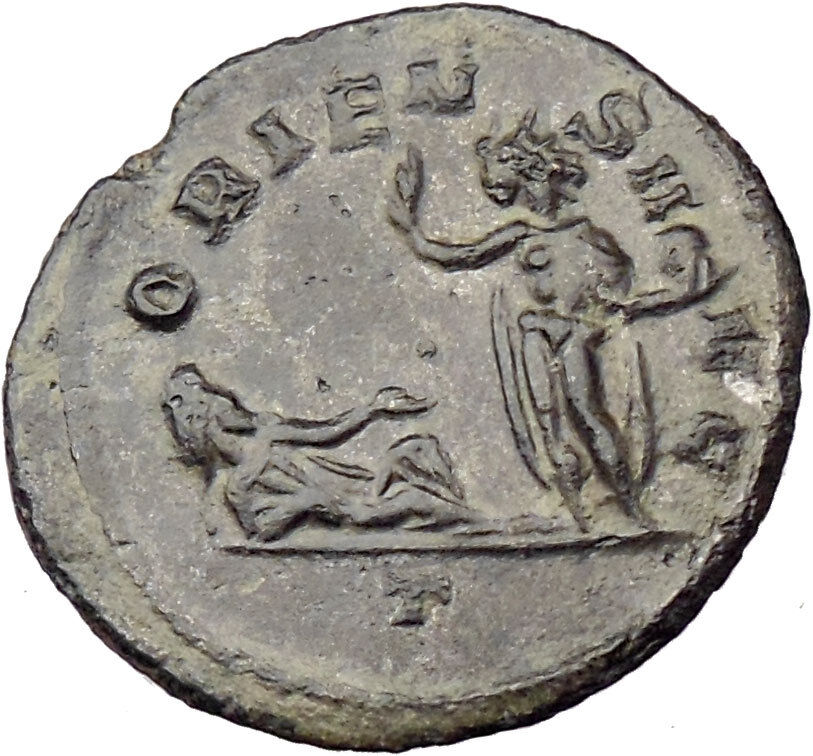|
Philip
I ‘the Arab’ –
Roman Emperor
: 244-249 A.D. –
Silver Antoninianus 23mm (4.24 grams) Rome mint: 247 A.D.
Reference: RIC 29, C 32
IMPMIVLPHILIPPVSAVG – Radiate, draped and cuirassed bust right.
ANNONAAVGG – Annona standing left, holding grain ears over galley prow and
cornucopia.
You are bidding on the exact item pictured,
provided with a Certificate of Authenticity and Lifetime Guarantee of
Authenticity.
The cornucopia (from Latin cornu copiae) or horn of plenty
is a symbol of abundance and nourishment, commonly a large horn-shaped container
overflowing with produce, flowers, nuts, other edibles, or wealth in some form.
Originating in
classical antiquity
, it has continued as a
symbol in
Western art
, and it is particularly associated
with the
Thanksgiving
holiday in
North America
.

Allegorical
depiction of the Roman
goddess
Abundantia
with a cornucopia, by
Rubens
(ca. 1630)
In Mythology
Mythology
offers multiple
explanations of the origin
of the cornucopia.
One of the best-known involves the birth and nurturance of the infant
Zeus, who had to be hidden from his devouring father
Cronus
. In a cave on
Mount Ida
on the island of
Crete
, baby Zeus was cared for and protected by
a number of divine attendants, including the goat
Amalthea
(“Nourishing Goddess”), who fed him
with her milk. The suckling future king of the gods had unusual abilities and
strength, and in playing with his nursemaid accidentally broke off one of her
horns
, which then had the divine power to
provide unending nourishment, as the foster mother had to the god.
In another myth, the cornucopia was created when
Heracles
(Roman
Hercules
) wrestled with the river god
Achelous
and wrenched off one of his horns;
river gods were sometimes depicted as horned. This version is represented in the
Achelous and Hercules
mural painting
by the
American Regionalist
artist
Thomas Hart Benton
.
The cornucopia became the attribute of several
Greek
and
Roman deities
, particularly those associated
with the harvest, prosperity, or spiritual abundance, such as personifications
of Earth (Gaia
or
Terra
); the child
Plutus
, god of riches and son of the grain
goddess Demeter
; the
nymph
Maia
; and
Fortuna
, the goddess of luck, who had the power
to grant prosperity. In
Roman Imperial cult
, abstract Roman deities who
fostered peace (pax
Romana) and prosperity were also depicted with a cornucopia,
including Abundantia
, “Abundance” personified, and
Annona
, goddess of the
grain supply to the city of Rome
.
Pluto
, the classical ruler of the underworld in
the
mystery religions
, was a giver of agricultural,
mineral and spiritual wealth, and in art often holds a cornucopia to distinguish
him from the gloomier Hades
, who holds a
drinking horn
instead.
Modern depictions
In modern depictions, the cornucopia is typically a hollow, horn-shaped
wicker basket filled with various kinds of festive
fruit
and
vegetables
. In North America, the cornucopia
has come to be associated with
Thanksgiving
and the harvest. Cornucopia is
also the name of the annual November Wine and Food celebration in
Whistler
, British Columbia, Canada. Two
cornucopias are seen in the
flag
and
state seal
of
Idaho
. The Great
Seal
of
North Carolina
depicts Liberty standing and
Plenty holding a cornucopia. The coat of arms of
Colombia
,
Panama
,
Peru and
Venezuela
, and the Coat of Arms of the State of
Victoria, Australia
, also feature the
cornucopia, symbolising prosperity.
The horn of plenty is used on body art and at Halloween, as it is a symbol of
fertility, fortune and abundance.
-
Base of a statue of
Louis XV of France
In
ancient Roman religion
, Annona (from
Latin
annus, year is the divine
personification
of the
grain supply to the city of Rome
. She is
closely connected to the goddess
Ceres
, with whom she is often depicted in
art
.
Annona, often as Annona
Augusti
, was a creation of
Imperial religious propaganda
, manifested in
iconography
and cult practice. She is presented
as an epiphany
of the
emperor
‘s power to care for his people through
the provision of grain. Annona thus lacked
narrative mythology
or a
tradition of devotion
in the
Roman Republic
, but once established as part of
Imperial cult
, she was the recipient of
dedications and votive offerings
from private
individuals motivated by gratitude or the seeking of favor.
Imperial cult
In the propaganda of
Claudius
, the cult of Ceres Augusta made
explicit the divine power that lay in the Imperial provision of the annona,
the grain supply to the city. Annona Augusti appears on
coins
late in the reign of
Nero, when the Cult of Virtues came into prominence in the wake of
the
Pisonian conspiracy
. She embodied two of the
material benefits of
Imperial rule
, along with Securitas Augusti,
“Augustan Security,” and often appeared as part of a pair with Ceres. On
Neronian coinage, Ceres, Annona, and
Abundantia
(“Abundance”) were closely
associated.
Annona also appears on coins issued under
Vespasian
, where along with other Virtues she
represents the restoration of confidence in the
principate
, and on the coinage of
Titus
,
Domitian
,
Trajan
,
Hadrian
,
Antoninus Pius
, and
Septimius Severus
. She was a particular
favorite in Trajan’s propaganda, which sought to portray his reign as a renewal
and a prosperous new era for mankind; hence Annona often appears with a symbolic
child. In the context of Trajanic politics, Annona represented Rome’s grain
independence from its traditional supplier
Egypt
.
Iconography
Annona is typically depicted with a
cornucopia
(horn of plenty) in her arm, and a
ship’s prow in the background, alluding to the transport of grain into the
harbor of Rome. On coins, she frequently stands between a
modius
(grain-measure) and the prow of a
galley
, with ears of grain in one hand and a
cornucopia in the other; sometimes she holds a
rudder
or an
anchor
.
Marcus
Julius Philippus or Philippus I Arabs (c. 204–249), known in
English
as Philip the Arab or formerly (prior to World War II) in
English as Philip the Arabian, was a
Roman
Emperor
from 244 to 249.
//
Little is known about Philip’s early life and political
career. He was born in
Shahba
, about
55 miles southeast of
Damascus
,
in the
Roman province
of
Syria
. Philip has the nickname “the Arab” because he had family who had
originated in the
Arabian peninsula
, believed to be distant descendants of the prestigious
Baleed family of Aleppo
. Philip was the son of a Julius Marinus, a local Roman citizen,
possibly of some importance. Many historians[1][2][3]
agree that he was of Arab descent who gained
Roman citizenship
through his father, a man of considerable influence. Many
citizens from the provinces took Roman names upon acquiring citizenship. This
makes tracing his Arabic blood line difficult. However, it is documented that
Rome used the
Ghassan
tribe from the
Azd of
Yemen
as vassals
to keep the neighboring northern Arabs in check.
The name of Philip’s mother is unknown, but sources refer to
a brother,
Gaius Julius Priscus
, a member of the
Praetorian guard
under
Gordian
III
(238–244). In 234, Philip married
Marcia Otacilia Severa
, daughter of a Roman Governor. They had two children:
a son named Marcus Julius Philippus Severus (Philippus
II) in 238 and according to numismatic evidence they had a daughter called
Julia Severa or Severina, whom the ancient Roman sources don’t mention.
Philip became a member of the
Pretorian Guard
during the reign of the emperor
Alexander Severus
, who was a Syrian. In ancient Rome the Pretorian Guard was
closely associated with the emperor, serving among other things as the emperor’s
bodyguard.
Political
career
In 243, during
Gordian
III
‘s campaign against
Shapur I
of
Persia, the
Praetorian prefect
Timesitheus
died under unclear circumstances. At the suggestion of his
brother Priscus, Philip became the new Praetorian prefect, with the intention
that the two brothers would control the young Emperor and rule the Roman world
as unofficial regents. Following a military defeat, Gordian III died in 244
under circumstances that are still debated. While some claim that Philip
conspired in his murder, other accounts (including one coming from the Persian
point of view) state that Gordian died in battle. Whatever the case, Philip
assumed the purple following Gordian’s death. According to Edward Gibbon:
His rise from so obscure a station to the first dignities
of the empire seems to prove that he was a bold and able leader. But his
boldness prompted him to aspire to the throne, and his abilities were
employed to supplant, not to serve, his indulgent master.
Philip was not willing to repeat the mistakes of previous
claimants, and was aware that he had to return to
Rome in order to
secure his position with the
senate
. He thus travelled west, after concluding a peace treaty with Shapur
I, and left his brother Priscus as extraordinary ruler of the Eastern provinces.
In Rome he was confirmed
Augustus
, and nominated his young son
Caesar
and heir.
Philip’s rule started with yet another
Germanic
incursion on the provinces of
Pannonia
and the Goths
invaded Moesia
(modern-day Serbia
and Bulgaria
)
in the Danube
frontier. They were finally defeated in the year 248, but the
legions
were not satisfied with the result, probably due to a low share of the plunder,
if any. Rebellion soon arose and
Tiberius
Claudius Pacatianus
was proclaimed emperor by the troops. The uprising was
crushed and Philip nominated
Gaius Messius
Quintus Decius
as governor of the province. Future events would prove this
to be a mistake. Pacatianus’ revolt was not the only threat to his rule: in the
East, Marcus Jotapianus
led another uprising in response to the oppressive rule of
Priscus
and the excessive taxation of the Eastern provinces. Two other
usurpers, Marcus Silbannacus
and
Sponsianus
,
are reported to have started rebellions without much success.
In April
A.D.
248 (April 1000
A.U.C.
), Philip had the honour of leading the celebrations of the one
thousandth birthday of Rome, which according to tradition was
founded
in 753 BC by
Romulus
. He combined the anniversary with the celebration of Rome’s alleged
tenth saeculum
.
According to contemporary accounts, the festivities were magnificent and
included spectacular games,
ludi saeculares
, and theatrical presentations throughout the city. In the
coliseum, more than 1,000 gladiators were killed along with hundreds of exotic
animals including hippos, leopards, lions, giraffes, and one rhinoceros.
The events were also celebrated in literature, with several publications,
including
Asinius Quadratus
‘s History of a Thousand Years, specially prepared
for the anniversary.
Despite the festive atmosphere, discontent in the legions was
growing. Decius
(249–251) was proclaimed Emperor by the Danubian armies in the spring of 249 and
immediately marched to Rome. Philip’s army met the usurper near modern
Verona
that summer. Decius won the battle and Philip was killed sometime in
September 249,
either in the fighting or assassinated by his own soldiers who were eager to
please the new ruler. Philip’s eleven-year-old son and heir may have been killed
with his father and Priscus disappeared without a trace.
Religious
beliefs
Further information:
Philip the Arab and Christianity
Some later traditions, first mentioned in the historian
Eusebius
in his
Ecclesiastical History
, held that Philip was the first
Christian
Roman emperor. This tradition seems to be based on reports in
Eusebius that Philip allegedly had once entered a Christian service on Easter,
after having been required by a bishop to confess his sins. Later versions
located this event in Antioch.
However, historians generally identify the later Emperor
Constantine, baptised on his deathbed, as the first Christian emperor, and
generally describe Philip’s adherence to Christianity as dubious, because
non-Christian writers do not mention the fact, and because throughout his reign,
Philip to all appearances (coinage, etc.) continued to follow the
state religion
.
Critics ascribe Eusebius’ claim as probably due to the tolerance Philip showed
towards Christians.
Saint Quirinus of Rome
was, according to a legendary account, the son of
Philip the Arab.
|











